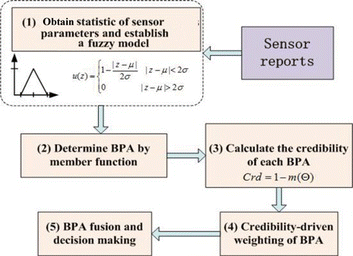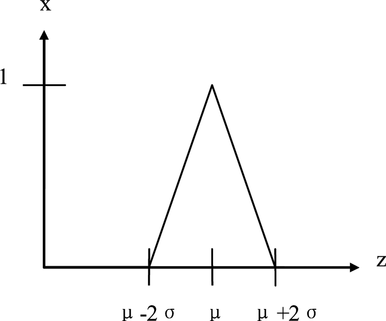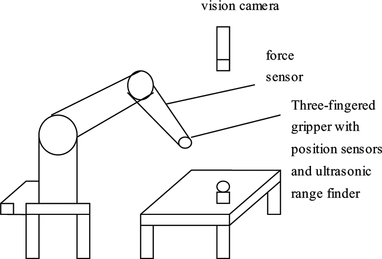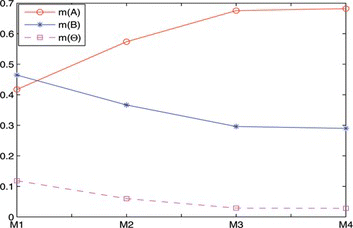Abstract
In multisensor systems, complementary observations from different sensors need to be combined with each other. Due to the uncertainty, sensor reports can be represented by fuzzy sets in order to efficiently deal with signal processing. In this article, a methodology to combine sensor reports in fuzzy environments based on Dempster–Shafer evidence theory is proposed. The basic probability assignment function is constructed by means of member functions. The numerical example on object recognition of a robot arm is shown to illustrate the efficiency of the presented approach.
INTRODUCTION
In a complex measurement system with many sensors, each sensor will obtain only partial information. To make rational decisions, the sensor observations must be combined into a global estimate based on information fusion technology. Information fusion is widely used in many application fields, such as classification or pattern recognition (Bi et al., Citation2007; Guo, Shi, and Deng Citation2006; Gargiulo, Mazzariello, and Sansone Citation2012; Deng et al., Citation2013), image processing and analysis (Rombaut and Zhu, Citation2002; Ghaderi, Mollaei, and Hojjatoleslami Citation2013), decision making and risk assessment (Deng and Chan, Citation2011; Feng and Li, Citation2011; Deng et al., Citation2011; Xiao et al., Citation2012; Zhang et al., Citation2012), and other applications (Zhao, Wang, and Qian Citation2012; Sarinnapakorn and Kubat, Citation2008; Deng et al., Citation2004; Ayati and Mohammadzadeh Moghaddam, Citation2012; and Kang et al., Citation2012).
In some application systems, intelligent sensor modules use local data to form an opinion on hypotheses put forward by the controller. Because of the uncertainty, sensor reports or sensor opinions can be represented by fuzzy sets (Zadeh, Citation1965) to handle uncertain information processing in a flexible way. As a result, an open issue is, how to combine fuzzy sensor reports?
In the framework of Dempster–Shafer evidence theory (Dempster, Citation1967; Shafer, Citation1976), information fusion relies on the use of a combination rule allowing the belief functions for the different propositions to be combined. A crucial role in evidence theory is played by Dempster's combination rule that has several interesting mathematical properties such as commutativity and associativity. In this article, a method to combine fuzzy information based on the Dempster–Shafer evidence theory is proposed.
This article is organized as follows. In “Preliminaries”, some preliminaries about fuzzy sets and evidence theory are brief introduced. The proposed method is presented in “Combine Fuzzy Information Based on Evidence Theory”. A numerical example in object recognition of robot systems is used to illustrate the efficiency of the proposed method in “Application in Robot Systems”. Conclusions are drawn in the final section of this article.
PRELIMINARIES
In this section, we briefly introduce some preliminaries about evidence theory and fuzzy sets.
Evidence Theory
Evidence theory (Dempster, Citation1967; Shafer, Citation1976) first supposes the definition of a set of hypotheses Θ called the frame of discernment, defined as follows:
It is composed of N exhaustive and exclusive hypotheses. From the frame of discernment Θ, let us denote P(Θ), the power set, composed with the 2 N propositions A of Θ:
In the case of imperfect data (uncertain, imprecise, and incomplete), fusion is an interesting solution with which to obtain more relevant information. Evidence theory offers appropriate aggregation tools. From the basic belief assignment denoted m i obtained for each information source S i , it is possible to use a combination rule in order to provide combined masses synthesizing the knowledge of the different sources.
Dempster's rule of combination (also called orthogonal sum), noted by m = m 1 ⊕ m 2, is the first within the framework of evidence theory that can combine two BPAs, m 1 and m 2, to yield a new BPA:
Based on the generalized insufficient reason principle proposed in the transferable belief model (TBM; Smets and Kennes, Citation1994), a probability function derived from a BPA is defined for the purpose of decision making via the so-called pignistic probability transformation (PPT; Smets and Kennes, Citation1994; Smets, Citation2005) defined as follows.
Definition 2.2
Let m be a BPA on a frame of discernment Θ, a pignistic probability transformation function BetP m : Θ → [0, 1] corresponding to m is defined by
Fuzzy Sets Theory
Fuzzy set theory (Zadeh, Citation1965) was first introduced by Zadeh in Citation1965 to deal with the uncertainty as a result of imprecision or vagueness. In some real application environments, the states are subjective concepts that are too complex or too ill defined to be reasonably described in conventional quantitative expressions. In addition, the states of situations are not certain sometimes. In those situations, fuzzy set theory provides an efficiently simple way to express the vagueness or imprecise information. In recent years, it is widely used in multicriteria decision-making (Yong and Qi, Citation2005; Kaur and Kumar, Citation2013; Xiao et al., Citation2012; Erkayman, Gundogar, and Yilmaz Citation2012), path selection (Deng et al., Citation2012), risk assessment (Abdul Kadir et al., Citation2013), clustering analysis (Kumar, Citation2012), time series forecasting (Joshi and Kumar, Citation2012), and other applications (Pellegrino, Citation2012; Ribaric and Pavesic, Citation2009; Barbosa and Real, Citation2012; Cheng, Fan and Huang Citation2012; Liu et al., Citation2012; Sahin, Kose, and Selbas Citation2012).
Definition 2.3
“Fuzzy set”: Let X be a universe of discourse, where is a fuzzy subset of X; and for all x ∈ X, there is a number
which is assigned to represent the membership degree of x in
, and is called the membership function of
(Zadeh Citation1965; Kauffman and Gupta Citation1985).
Definition 2.4
“Fuzzy number”: A fuzzy number is a normal and convex fuzzy subset of X (Kauffman and Gupta, Citation1985).
Here, “normality” implies that
Definition 2.5
A triangular fuzzy number can be defined by a triplet (a, b, c), where the membership can be determined as follows
COMBINE FUZZY INFORMATION BASED ON EVIDENCE THEORY
As can be seen from the previous section, each piece of basic probability assignment (BPA) can be combined easily, based on the Dempster–Shafer evidence theory. One of the important issues is how to determine the BPA in real application systems. In this section, we propose a method to combine fuzzy sensor opinions based on the Dempster–Shafer evidence theory. It mainly consists of five steps, as shown in Figure . The first step to obtain is the statistic of sensor parameters and establish a fuzzy model. The BPA by member function is determined in the second step. In the third step, the credibility of each BPA is calculated, and then the new BPA, based on the credibility-driven weighting method, is obtained. Finally, the sensor BPAs are combined and a decision is made.
Obtain Statistic of Sensor Parameters and Establish a Fuzzy Model
Each sensor is an information resource to report the data of objects. According to these data, some statistical parameters, such as mean and standard deviation, can be obtained. These statistical parameters are used to form an opinion for the objects. As a result, a fuzzy model can be established based on the statistical parameters.
For example, assume there are some sensors such as force, range finder, vision and gripper. The parameters measured by the sensors are Gaussian, with mean and standard deviation given by Table . Based on a triangular function as shown in Figure , a fuzzy model for each sensor is established to form an opinion x as follows:
TABLE 1 Mean and Standard Deviation for Measured Parameters
Determine BPA by Member Function
After representation of measurement parameters, the sensor opinions can be transformed into fuzzy member functions by the means of similarity measure. For example, we use the data in Table . Assume the value of force sensor report is 257, shown in Table . Hence, the opinions to support hypotheses “object is A” can be calculated as follows:
TABLE 2 Example Sensor Data
In a similar way, the opinions to support hypotheses “object is B” can be calculated as follows:
The opinions to support hypotheses “object is Unknown” can be calculated as follows:
Normalize the member function list above, then the BPA of force sensor report can be shown as follows:
By the same methods, we can get the BPA of other sensors. For example, there are four sensor reports in Table , and four relative BPAs can be obtained:
Calculate the Credibility of Each BPA
Because of existing differences in the accuracy and reliability of sensors, it should be noted that the credibility of BPAs derived from various sensors is different. However, these BPAs determined in the subsection are raw, which cannot reflect the relative credibility of BPAs. In this study, an index to the sensor BPA's credibility is proposed as follows.
Definition 3.1
Let m be a basic probability assignment; the credibility of m is defined as
Take m 2: m 2(A) = 0.6, m 2(B) = 0.2, m 2(Θ) = 0.2 as an example, its credibility is
Credibility-Driven Weighting of BPA
In this step, these raw BPAs are weighted to obtained the new BPAs according to their credibility.
Let Θ be the frame of discernment, m
j
is a raw BPA, and a new BPA after weighting is indicated by . The weighting operation is accomplished as follows.
For example, because the credibility of m 2 is 0.4, the weighted BPA of m 2 is
BPA Fusion and Decision Making
After all BPAs are weighted, the combined BPA can be obtained by the use of combination rule in Equation (Equation5) that
APPLICATION IN ROBOT SYSTEMS
To test the algorithms developed above, a simple object-recognition task coming from literature (Odeberg, Citation1993) is simulated (Figure ). The task is to discriminate between two objects, labeled A and B, respectively. The sensors available are as follows: (1) a vision camera, programmed to find any objects; (2) an ultrasonic ranger finder that measures the height of an object; (3) position sensors, mounted on the robot gripper, that measure the size of a gripped object; (4) a force sensor, mounted on the robot arm, that measures the weight of a gripped object.
Assume that the parameters measured by the sensors are Gaussian, with mean and standard deviation given by Table . Assume that the measurement data of Table have been acquired. This will result in sensor opinions according to Table , where Table , Table , Table , and Figures and 3 are from literature (Odeberg, Citation1993).
TABLE 3 Sensor Opinions for Example Sensor Data
Then, we can get the BPAs of the four sensor reposts using our proposed BPA determination method. The obtained raw BPAs are shown as follows:
According to Equation (Equation12), the credibility of each BPA can be calculated, as shown in Table .
TABLE 4 Credibility of Each BPA
By weighting the raw BPAs, the weighted BPAs are obtained as follows:
Based on the combination rule in Equation (Equation5), the combined BPAs of these sensors are listed in Table and in Figure . In Table , each step fusion result of evidence cumulation is shown.
TABLE 5 Results of Sensor BPA Fusion
Finally, transform the BPAs into probability distributions using the PPT function. In order to observe the change of each object's probability, Table shows the probability distributions associated with the process of BPA fusion, and this is shown graphically in Figure . As can be seen from Tables , and 6 and Figures , and 5, the object is A. With the cumulation of evidence, the support to hypothesis “Object is A” increases whereas the unknown value decreases, which means that the systems takes advantage of multisensor data fusion technology.
FIGURE 5 Probability distributions of objects in the process of BPA fusion. (Color figure available online.)
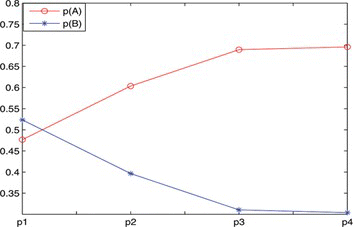
TABLE 6 Probability Distributions Associated with the Process of BPA Fusion
CONCLUSION
In this article, a method based on the Dempster–Shafer evidence theory to combine fuzzy sensor opinions in robot systems is proposed. First, the parameters can be represented by triangular fuzzy numbers, and the measurement value can be transformed into member function to establish a fuzzy sensor model. Then the raw BPA of each sensor opinion can be calculated through the member function. Next, the raw BPA is weighted using the credibility of each BPA. Finally, the weighted BPAs can be combined by the use of the Dempster combination rule, and the derived BPA can be transformed into a probability distribution. A numerical example to object recognition in a robot system is used to show the efficiency of the proposed method. The reliability of each sensor may be taken into consideration to improve the object ability in our future research.
Acknowledgments
The work is partially supported by National Natural Science Foundation of China, Grant No.61174022, Chongqing Natural Science Foundation, Grant No. CSCT, 2010BA2003, National High Technology Research and Development Program of China (863 program), Grant No. 2013AA013801.
REFERENCES
- Abdul Kadir M. K. , E. L. Hines , K. Qaddoum , R. Collier , E. Dowler , W. Grant , M. Leeson , D. Iliescu , A. Subramanian , and K. Richards . 2013 . Food security risk level assessment: A fuzzy logic-based approach . Journal of Applied Artificial Intelligence 27 ( 1 ): 50 – 61 .
- Ayati , E. , and A. Mohammadzadeh Moghaddam . 2012 . Introducing roadside hazard severity indicator based on evidential reasoning approach . Safety Science 50 ( 7 ): 1618 – 1626 .
- Barbosa , A. M. , and R. Real . 2012 . Applying fuzzy logic to comparative distribution modelling: A case study with two sympatric amphibians . The Scientific World Journal Article ID 428206.
- Bi , Y. , D. Bell , H. Wang , G. Guo , J. Guan . 2007. Combining multiple classifiers using Dempster's rule for text categorization. Journal of Applied Artificial Intelligence 21 (3): 211–239.
- Cheng , Y. , Y. Fan , and M. Huang . 2012 . Innovative intelligent navigation system by applying fuzzy logic and cell assemblies in rescuing robot . Applied Artificial Intelligence 26 ( 3 ): 183 – 203 .
- Dempster , A. P. 1967 . Upper and lower probabilities induced by a multivalued mapping . Annals of Mathematics and Statistics 38 ( 2 ): 325 – 339 .
- Deng , X. , Q. Liu , Y. Hu , and Y. Deng . 2013 . TOPPER: Topology prediction of transmembrane protein based on evidential reasoning . The Scientific World Journal Article ID 123731.
- Deng , Y. , and F. T. S. Chan . 2011 . A new fuzzy Dempster MCDM method and its application in supplier selection . Expert Systems with Applications 38 ( 8 ): 9854 – 9861 .
- Deng , Y. , F. T. S. Chan , Y. Wu , and D. Wang . 2011 . A new linguistic MCDM method based on multiple-criterion data fusion . Expert Systems with Applications 25 ( 8 ): 6985 – 6993 .
- Deng , Y. , Y. Chen , Y. Zhang , and S. Mahadevan . 2012 . Fuzzy Dijkstra algorithm for shortest path problem under uncertain environment . Applied Soft Computing 12 ( 3 ): 1231 – 1237 .
- Deng , Y. , W. K. Shi , Z. F. Zhu , and Q. Liu . 2004 . Combining belief functions based on distance of evidence . Decision Support Systems 38 ( 3 ): 489 – 493 .
- Erkayman , B. , E. Gundogar , and A. Yilmaz . 2012 . An integrated fuzzy approach for strategic alliance partner selection in third-party logistics . The Scientific World Journal Article ID 486306 .
- Feng , N. , and M. Li . 2011 . An information systems security risk assessment model under uncertain environment . Applied Soft Computing 11 ( 7 ): 4332 – 4340 .
- Gargiulo , F. , C. Mazzariello , and C. Sansone . 2012 . Automatically building datasets of labeled IP traffic traces: A self-training approach . Applied Soft Computing 12 ( 6 ): 1640 – 1649 .
- Ghaderi , J. G. R. , M. R. Mollaei , and S. A. Hojjatoleslami . 2013 . A novel fuzzy Dempster-Shafer inference system for brain MRI segmentation . Information Sciences 223 : 205 – 220 .
- Guo , H. W. , W. K. Shi , and Y. Deng . 2006 . Evaluating sensor reliability in classification problems based on evidence theory . IEEE Transactions on Systems Man and Cybernetics Part B: Cybernetics 36 ( 5 ): 970 – 981 .
- Joshi , B. P. , and S. Kumar . 2012 . Intuitionistic fuzzy sets based method for fuzzy time series forecasting . Cybernetics and Systems 43 ( 1 ): 34 – 47 .
- Kang , B. , Y. Deng , R. Sadiq , and S. Mahadevan . 2012 . Evidential cognitive maps . Knowledge-Based Systems 35 : 77 – 86 .
- Kauffman , A. , and M. M. Gupta . 1985 . Introduction of fuzzy arithmetic: Theory and applications . New York : Van Nostrand Reinhold .
- Kaur , M. , and A. Kumar . 2013 . Optimal compromise solution of multi-objective minimal cost flow problems in fuzzy environment . Applied Mathematical Modelling 37 ( 4 ): 1677 – 1693 .
- Kumar , C. A. 2012 . Fuzzy clustering-based formal concept analysis for association rules mining . Journal of Applied Artificial Intelligence 26 ( 3 ): 274 – 301 .
- Liu , J. , F. T. S. Chan , Y. Li , Y. Zhang , and Y. Deng . 2012 . A new optimal consensus method with minimum cost in fuzzy group decision . Knowledge-Based Systems 35 : 357 – 360 .
- Odeberg , H. 1993 . Distance measures for fuzzy sensor opinions . Measurement Science & Technology 4 ( 8 ): 808 – 815 .
- Pellegrino , O. 2012 . The application of drivers'cognitive reliability using fuzzy techniques . Journal of Applied Artificial Intelligence 26 ( 6 ): 517 – 540 .
- Ribaric , S. , and N. Pavesic . 2009 . Inference procedures for fuzzy knowledge representation scheme . Journal of Applied Artificial Intelligence 23 ( 1 ): 16 – 43 .
- Rombaut , M. , and Y. M. Zhu . 2002 . Study of Dempster-Shafer theory for image segmentation applications . Image and Vision Computing 20 ( 1 ): 15 – 23 .
- Sahin , A. S. , I. I. Kose , and R. Selbas . 2012 . Comparative analysis of neural network and neuro-fuzzy system for thermodynamic properties of refrigerants . Journal of Applied Artificial Intelligence 26 ( 7 ): 662 – 672 .
- Sarinnapakorn , K. , and M. Kubat . 2008 . Induction from multi-label examples in information retrieval systems: A case study . Journal of Applied Artificial Intelligence 22 ( 5 ): 407 – 432 .
- Shafer , G. 1976 . A mathematical theory of evidence . Princeton , NJ : Princeton University Press .
- Smets , P. 2005 . Decision making in the TBM: The necessity of the pignistic transformation . International Journal of Approximate Reasoning 38 ( 2 ): 133 – 147 .
- Smets , P , and R. Kennes . 1994 . The transferable belief model . Artificial Intelligence 66 ( 2 ): 191 – 234 .
- Xiao , Z. , S. Xia , K. Gong , and D. Li . 2012. The trapezoidal fuzzy soft set and its application in MCDM. Applied Mathematical Modelling 36 (12): 5844–5855.
- Xiao , Z. , X. Yang , Q. Niu , Y. Dong , K. Gong , S. Xia , and Y. Pang . 2012 . A new evaluation method based on D-S generalized fuzzy soft sets and its application in medical diagnosis problem . Applied Mathematical Modelling 36 ( 10 ): 4592 – 4604 .
- Yong , D. , and L. Qi . 2005 . A TOPSIS-based centroid-index ranking method of fuzzy numbers and its application in decision-making . Cybernetics and Systems 36 ( 6 ): 581 – 595 .
- Zadeh , L. A. 1965 . Fuzzy sets . Information and Control 8 ( 3 ): 338 – 353 .
- Zhang , Y. , X. Deng , D. Wei , and Y. Deng . 2012 . Assessment of E-Commerce security using AHP and evidential reasoning . Expert Systems with Applications 39 ( 3 ): 3611 – 3623 .
- Zhao , L. , X. Wang , and Y. Qian . 2012 . Analysis of factors that influence hazardous material transportation accidents based on Bayesian networks: A case study in China . Safety Science 50 ( 4 ): 1049 – 1055 .
